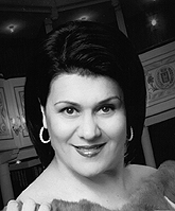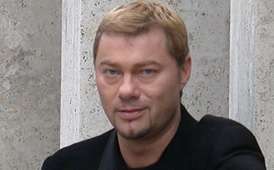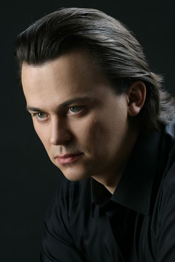
30 Jul 2008
Don Carlo at Wiener Staatsoper
Star-studded casts graced end of the season performances at the Wiener Staatsoper, with two versions of Verdi’s Don Carlo on its menu.
For its ninth program of the Summer 2008 season the Grant Park Music Festival offered a balance of vocal, choral, and orchestral works from the late nineteenth and first half of the twentieth centuries.
I discovered many delights in my first ever visit to the Chautauqua Opera, not least of which was the lovely environment of the hilly Chautauqua Institution grounds which are dotted with picturesque and inviting old frame houses.
The novelty feature drawing veteran opera enthusiasts in general, and Richard Wagnerites in particular to Glimmerglass Opera this summer is that composer’s “Das Liebesverbot,” in what is touted as the North American fully staged premiere of this seldom-talked-about-and-even-less-performed early piece.
For two years, the subdued rumble of anticipation had been building to a forte.
It’s not so long ago that the opening night of the Proms was given over to a single major choral work, but in more recent times it has become more of an overt opener to the season, presenting a taster menu of the themes running through the season’s subsequent 70-plus concerts.
Eugenia Zukerman asked for a 10-minute chamber work — a piano quintet, perhaps — and she got Green Sneakers for Baritone, String Quartet and Empty Chair, which lasts exactly an hour.
“Quelle plaisir” to encounter Gustave Charpentier’s seldom performed “Louise” at the Paris Opera in a production where most everything went spectacularly right.
The Bayerische Staatsoper, based in three spectacular houses where Mozart, Wagner and many other composers premiered their works, presents over 300 annual performances to a discerning public.
Bernd Alois Zimmermann was a sensitive, none too healthy 21-year-old music prodigy in 1939, when he was drafted into the German army.
For Sir William Walton, the protracted genesis of Troilus and Cressida must have seemed more akin to the agonies of Sisyphus than to the composition of an opera.
Originating at the Châtelet, where the narration was given in French, Robert Carsen's staging of Bernstein's unique satire worked rather well in its television broadcast from the Parisian house late in 2006.
The disastrous 1904 La Scala premiere of Giacomo Puccini’s Madame Butterfly is one of those famous annals of opera which tend to leave today’s audiences perplexed about all the uproar.
The concert “20th-Century Masters,” presented by the Grant Park Music Festival, Chicago on 27 and 28 June 2008 featured several pieces performed for the first time under the auspices of the Festival.
David Gockley heard the cries of many an opera fan that Pamela Rosenberg had denied them their 'stars,' so for his summer season, 2008, he brought them Natalie Dessay, Susan Graham, Ruth Ann Swenson, and Stefan Margita.
My visit to two rarely mounted pieces at the Opera Festival of St. Louis brought to mind the little girl with the curl, for when it was good, it was very very good and when it was bad, it was, um. . .er. . .
In the latter part of last year, the casting for Nicholas Hytner’s new production of Don Carlo — in the five-act Italian version — looked to be on shaky ground.
No one has ever called Gazzaniga’s Don Giovanni an overlooked masterpiece.
Pink flamingos, sheep on wheels, and a queen crowned with giant antlers all inhabit the zany world of Opera Theatre of Saint Louis’s Una cosa rara, where the artificial 18th century pastoral commingles with cutesy country colors and 1950s yard art.
On the barren stage: a few chairs, a dark-gold hectoplasm projected on the wood panels of the acoustic chamber - nothing more.
At the curtain call for the first night of WNO’s new production of the infrequently performed Khovanshchina director David Pountney wore a simple Russian shirt.

Star-studded casts graced end of the season performances at the Wiener Staatsoper, with two versions of Verdi’s Don Carlo on its menu.
The Italian and French version, both equally interesting for their individuality, were offered simultaneously this season. While the subject of Schiller’s Don Carlo had previously been suggested to Verdi, he initially rejected it as a possibility, probably because German literature was frowned upon prior to the Italian unification in 1861. By 1865, he reconsidered the subject, setting it first in French. Verdi decided to add two scenes to the original drama, however, to enhance its marketability: the scene between Philip and Posa, and the scene between the Grand Inquisitor and Philip. By 1866, Verdi arrived in Paris with the completed opera, and began rehearsals at the Opéra de Paris.
Don Carlos received its Italian première in 1868 alongside Boito’s Mefistofele, but was not immediately successful. Albeit unsuccessful, Verdi revised the opera in an Italian version, which subsequently premièred in 1884. Interestingly, his revisions were to the French version, and so an authentic “Italian version” does not exist; it is merely an Italian translation of the revised French version. The Staatsoper’s simultaneous production of both versions in one season is intriguing and noteworthy.
Marco Armiliato steadily began the Italian version with a nicely interpreted and dramatic presentation of the Overture. The solemn introduction by four horns precedes the off-stage chorus and funeral dirge for Charles V. Janusz Monarcha sang the incantations of the Monk with clear and well-shaped lines, and a strong burnished sound. His timbre and eloquent legato combined to produce an ominous presence. He explains that Charles V was guilty of pride and folly. Kneeling, the chorus sings “Carlo, il sommo Imperatore,” to the sensitive and well-balanced support of the orchestra.
 Marco Armiliato
Marco Armiliato
Tenor, Franco Farina’s entrance left much to be desired. His orange-hued voice was large enough and suitable to the Verdian repertoire, however his lack of attention to the phrasing and shaping of his lines left his performance longing for beauty. Almost abrupt, his singing was heavy in the upper tessitura and rather than create squillo through good technique, his attempt at creating the Italianante sound of a true affogato generated more yelling than anything. Dramatic, however, in his scena of sorrow and anguish at losing Elisabetta, Farina displayed a passionate fervour.
Thomas Hampson’s Rodrigo was, for the most part, well performed if not over-sung in a few sections. Hampson’s voice sounds best when it is not forced, but the label of a ‘Verdian Baritone’ seems to demand a specific colour for him. Such labels are often not beneficial to singers. Rather than sing freely in their natural voice, it insinuates a manifestation of a sound that is rather pesante or pressato in order to sing these roles. Posa enters and is greeted by Carlo. He immediately launches into a description of the battle at Flanders, to which Carlo responds with his declaration of friendship. Their ensuing duet was memorable and well sung, except for a few sections in which Farina’s upper-register became too forced to remain sensitive to Hampson’s rounded lines. A beautiful orchestral fabric supported the final section of the duet, the cabaletta “Dio che nell’alma infondere,” sung shoulder to shoulder in well-effected thirds. Hampson’s Italian was well pronounced, although some Americanisms were obvious. Farina’s inability to blend rendered this energetic moment was still accepted by the audience, but not overly. Verdi’s melodramatic talent shines through as a procession passes by Carlo and Posa, who join in the chanting of the monks before a thrilling reprise of their cabaletta.
 Thomas Hampson
Thomas Hampson
Scene II brought a new stage setting, with large pillars and metal gates. The costumes for this production were traditional and ornate in royal hues. The female chorus, Elisabetta’s ladies-in-waiting, were not allowed in the monastery and amused themselves outside. Their singing, “Otto ai folti, immensi abeti” was well balanced and sung with accurate diction, and enthusiasm. Eboli, portrayed by mezzo-soprano Luciana D’Intino, sings her famous Veil Song, “Nel giardin del bello,” a two-stanza song with refrain. D’Intino’s voice is a more than noteworthy instrument, and her diction was offered with a strong accento puro. I will go so far as to promote that D’Intino will belong to the realm of great Italian mezzos like Simionato, Cossotto, and Barbieri. It is truly the voice a Verdian mezzo, unfettered. If a criticism is necessary, it is that the registers of her voice are not yet even, as is typically the technical issue with mezzos of this type, and at times it sounded like three separate singers. Ms. D’Intino’s chest register is tremendous, and deliciously rugged; even awesomely affective, however her middle-register was far removed from her chest timbre, generating a notable break in the voice. For a mezzo, her head register is also quite impressive, though she has to lighten the tone quite a lot to achieve it. Regardless, this singer is one to note for a bright future, especially for her dramatic and lovely presence. Her fioritura and ability to sing pianissimo was quite impressive.
 Luciana D’Intino
Luciana D’Intino
A disconsolate Elisabetta appears, portrayed by Soprano Norma Fantini, followed by Posa. He hands the Queen a letter from her mother in which a letter from Don Carlo is secretly hidden. Elisabetta reads the letter while Posa converses with Eboli. Since Posa has brought the letter, Elisabetta believes she can trust Posa. Unfortunately, the conversation between Eboli and Posa was not impressive and displayed the inconsistencies in Ms. D’Intino’s registers. Her attempt to mix timbres with Hampson was almost disturbing because she brought her chest register extremely high in her range. Hampson breaks into his cantabile romanza, “Carlo ch’e il sol il nostro amore,” in which he explains how Carlo was rejected by his father and requests an interview with his new “mother.” In a fine display of artistry, Hampson is sensitive and dramatic in his explanation. Elisabetta agrees to meet with Carlo, and Eboli and Posa leave.
 Norma Fantini
Norma Fantini
The duet between Farina and Norma Fantini was moving. While Fantini’s voice has lovely prospects, the tone is often hollow. It is not the most attractive of tones, but her attention to language allowed for an interesting portrayal. The orchestra, in this section, was slightly overbearing, but Armiliato quickly regained balance. Farina gave some of his nicest singing in this scene, although Ms. Fantini’s acting left the scene lacking in realism. In one of Verdi’s attempts to match musical progress to spoken dialogue, he gives up his conventional four-movement form and allows the duet to move, instead, through a series of dialogues. Carlo asks Elisabetta to intercede on his behalf with Philip, who will not allow him to leave for Flanders. Elisabeth agrees; no sooner, Carlo loses himself and pours out his affections for her. As the scene ends, Elisabetta rejects Carlo’s advances, telling him that he can only gain her love by killing his own father. The scene lacked in passionate interplay since Farina was unconvincing in his passionate gestures. Although his best singing was not met by dramatic expression, the scene was successful because of Ms. Fantini’s acting.
Philip’s arrival was dramatic and electrifying for René Pape’s bold basso, ricco d’energia. His voice is well-balanced, even throughout, with the loveliest spinning lines, and seamless application. Angry that Elisabetta has been left alone, he orders her lady-in-waiting back to France. Elisabeth bids the Countess farewell, although Ms. Fantini’s tone became rather nasal in this section and her diction was unclear. Her romanza did not generate warm applause. Philip, left alone, asks for Posa to remain in his company.
Hampson recounts Posa’s devoted soldierly life in a lovely moment of musicality and sensitivity, after which Philip stresses a need for political control to curb Posa’s idealism. In this scene, Pape’s vocal prowess was captivating. It was one of the evening’s most vocally and dramatically well-presented moments. Verdi pins the voices, dramatically, by allowing them to represent contrasting idioms; then, he unites them by the end. Pape’s warnings, “Beware the Inquisitor,” were not only vocally impressive, but also physically affective as Verdi attaches massive solemn chords to increase the emotional value of the scene. His dramatic understanding of Philip allowed us to gaze at his character from different angles and see contrasting parts of his personality. Pape’s portrayal of Philip is a multidimensional sensation. As he confides in Posa, about his troubled feelings, Posa brings Philip’s character to a new level of interest. In this production, Pape stood high above his colleagues in terms of vocal production, and most certainly dramatic understanding.
The final duet is interesting in terms of form. Initially, Verdi had used his consistent four-part formula, but the revision brought a complete abandoning of this form. Instead, he replaces it with a fluid dialogue of the type he would use later in Otello. Whether his adjustment had anything to do with the non-conventional Mefistofele that premièred simultaneously, is intriguing and noteworthy.
Act II began with a set change, dominated by a hazy sun surrounded by the mist of disconcertedness. Philip’s coronation is to occur the following day. An offstage chorus sings to the accompaniment of castanets. The chorus, here, was accurate and impressive with their diction, as well as their dramatic presence. Elisabetta appears with Eboli, and since the Queen is weary of the ensuing celebrations, she decides to exchange masks with Eboli. As Elisabeth leaves, Eboli sings a small solo that recalls the central section of the “Veil Song.” Unfortunately, the scene between Ms. Fantini, and Ms. D’Intino was vocally unimpressive. In Don Carlo, Verdi requires the female relationship to be as profound as the one between Philip and Posa, yet the relationship between Eboli and Elisabetta did not attain equal emphasis.
In the following scene, Carlo enters reading a letter he thinks is from Elisabetta. The scene follows the conventional four-movement format; however, it suffered because of Farina’s lack of vocal control. His Italian is excellent, but his phrasing for this moment in Carlo’s character required more intense shaping. Eboli appears and Carlo breaks into declarations of love, thinking that she is Elisabeth. The duet between Farina and D’Intino was not pleasant. Her voice, in constant fluctuation, used an almost forced chest register, and paired with Farina’s heavy singing, made the scene vocally uninteresting. Once identities are revealed, Eboli realizes that Carlo loves the queen.
Hampson enters as Posa and initiates the trio “Al mio furor sfuggite invano.” The trio brought some of the best singing of the evening. Verdi sets the baritone and mezzo’s agitated rhythms against the tenor’s long impassioned melody; however, Farina failed to effect a legato significant enough to create this effect. Carlo restrains Posa from killing Eboli, after which she intones furious curses on Carlo. Ms. D’Intino’s chest register shone here and she demonstrated the full extent of her powerful instrument purely and dramatically. Her lower register is impressive. As she rushed away, Hampson and Farina were left to end the scene offering each other declarations of trust. Farina, again, forced the voice in the upper register and failed to match Hampson’s more lyrical and spinning quality. The scene ended, however, with much applause and support of the singers.
The final scene of Act II brought the grandiose. A large, regal unity planted itself onstage for the crowning of Philip. Filled with pomp and supported by the magnificent tonal palate of Maestro Armiliato and his orchestra, the stage filled with a significant chorus and a full procession, complete with crucifixes. Wheeled out and placed center stage, three massive crucifixes stood erect with suffering heretics attached to them. Elisabetta enters, with an elegant and regal red gown, to illuminate the entrance of the King. Kudos to the staging director of the production and the costume director, for effecting the necessary pomp that this scene requires. It was a large dramatic visual event, as well as musical.
Much of the musical bearing of this scene is attributed to Mr. Pape, who was exquisite in his commentary. Six Flemish deputies, escorted by Carlo, confront Philip. They kneel before the King and lead into a grand concertato movement in which all the principle voices join. Farina used even more force in his upper register as did Ms. Fantini, allowing for a somewhat harsh sound, rather than the more sublime block of sound that Verdi might have required. Farina approaches as Carlo, asking to be sent to Flanders. His volume, never lower than an f throughout, added to Farina’s conversational moments, lacking finesse. In a significant vocal moment, Philip refuses Carlo’s pleas, upon which Carlo draws his sword. Posa steps forward and demands Carlo to surrender. Hampson was brilliant in this scene and added to the dramatic inflection initiated by Pape. Carlo relinquishes his weapon and Pape, in a most brilliant tone, announces Posa as a Duke. The scene closes with a splendid orchestral and choral sequence, juxtaposed with a voice from heaven that speaks of future bliss. The tremendous applause offered to Pape on his bow was significant and showed this audience to be aurally and visually intelligent.
Act III began with a heartfelt cello solo that stirred the soul, eloquently played by the principle cellist. Philip, alone in his study, begins his soliloquy, “Ella giammai m’amo,” in which Pape surpassed any of the singing he had presented earlier. He took command of his character and suddenly a thrilling and affective pathos sizzled through the air of the Staatsoper, touching everyone. Pape’s phrasing was sensitive and the beauty of his voice was touching, in and of itself. Not one phrase was without shape and his extensive use of messa di voce, especially for a lower fach, was exquisite. A luscious spin and impeccable diction capped this most spectacular performance of the evening. His sotto voce to end Philip’s aria, was chilling and imbued the most profound pathos possible. The applause and yelps of “Bravo” continued for two minutes afterward, stopping the action.
 René Pape
René Pape
The following scene brought the Grand Inquisitor, portrayed by Stefan Kocán, into duet with Philip. Kocán’s voice was interesting, because it seemed very light or high in timbre for a bass, although that is often the case with voices that are deep. The overtones often pick up and make the sound different when it travels through a large space. Nevertheless, Kocán had good rapport with Papè in this scene. The orchestral palate was exquisitely controlled by Maestro Armiliato, especially as Verdi places his concentration on the low strings, ostinato rhythms, restricted pitches, and sets the stage for the power struggle between the two basses. Philipp asks what to do with Carlo, but Verdi uses free declamation, allowing the Inquisitor to take control of the scene. The Inquisitor tells him that Posa is the more serious threat. Pape’s and Kocán’s artistry led the scene to an excited fervour, as the Inquisitor threatens Philip with a possible inquisition.
 Stefan Kocán
Stefan Kocán
Elizabeth enters the next scene, which is conventionally structured, announcing the theft of her jewellery case. Ms. Fantini’s dramatic abilities were strong, although her singing rather throaty and heavy. Her singing in the higher tessitura was somewhat strident, and although squillo is necessary, here it lacked a certain fullness and roundness. Maestro Armiliato and his orchestra were brilliant in this section, where his sensitivity to the dialogue was delightful. Pape enters with intensity and produces the jewellery case, finding the picture of Carlo in it, planted by Eboli. Philipp accuses Elisabetta of adultery. Pape’s furiousness and dramatic prowess led Ms. Fantini in her portrayal. Philip summons Posa and Eboli, who enter and join in the four-part ensemble, “Ah! si maledetto, sospetto fatale.” At first dominated by Philip, whose gradual statements lead into a lyrical section, his melody should weave with Posa’s decision to take action, and Eboli’s remorseful statements. Unfortunately, the quartet lacked because of Ms. D’Intino’s inconsistent register switching and Ms. Fantini’s forceful singing that created some flat tones in the upper tessitura. Pape and Hampson remained consistent throughout.
Philip and Posa leave Eboli and Elisabetta alone. A sudden infusion of chromaticism surrounds Eboli’s confession. Ms. D’Intino’s singing here was quite exquisite, and her register changes far less abrupt. Upon her confession, Elisabetta orders her to leave the court. Upon her departure, Eboli sings “O Don Fatale,” in which she laments her fatal beauty in conventional major-minor fluctuations. Ms. D’Intino’s singing was well blended here, immensely dramatic with well-presented inflection, and phrasing. Her attention to detail and the mixing of her registers made this quite exquisite. In the major section, she bids farewell to the Queen with a sensitivity that affected the audience into a grand gesture of appreciation for Ms. D’Intino.
The final scene of Act III brings Posa to Carlo, where Posa bids farewell to him in an old-fashioned romanza. Hampson’s singing was lovely and lyrical, with good attention to diction. He warranted the significant applause of the audience. A shot rings out and wounds Posa. Farina’s acting here was rather removed from Hampson’s strong attempts to create pathos and convincing agony. Again, Farina’s singing was heavy, and forced. Posa reveals to Carlo that Elisabeth awaits him at the monastery and subsequently delivers a second romanza before dying.
Grand orchestral sweeps commence Act IV. The accuracy and the terrific palate of colours possessed by the Wiener Philharmonic were evident. Ms. Fantini enters as Elizabeth, who unfortunately was less interesting in this final act. Her aria, “Tu che la vanità” was competently sung, although she did not do much more to enhance Verdi’s writing. There was much similar inflection throughout. Her high tessitura was markedly strident and the audience recognized the contrasts of this cast, bidding her well with lukewarm applause. It should be mentioned, however, that Ms. Fantini has a lovely sotto voce, that was even fuller and warm in its application than her regular singing, possibly suggesting a more lyric application for her. While Valois is a difficult role, vocally, it also rests on dramatic prowess, and unfortunately, Ms. Fantini did not impress pathos for her character upon this audience.
The final scene has Carlo and Elisabetta in a moment of metaphysical love, where earthly love is renounced for love in the afterlife. Farina’s singing “Ma lassù ci vedremo,” was not impressive vocally, but dramatic. It should be an ethereal type of cabaletta similar to the closing of Aida, in its restraint. Maestro Armiliato created such an effect with his delicate orchestral fabric. Suddenly, Philip bursts in. Pape, illuminated and dramatic, attempts to offer his son to the Inquisitor, but Carlo runs to the temple of Charles V. The tomb opens as a Monk appears, wearing a crown and mantle. He gathers Carlo to him and brings him into the cloister.
Unquestionably, René Pape led this production with vocal prowess and dramatic intention, along with Thomas Hampson and Stefan Kocán. Ms. D’Intino should also be commended for her impressive mezzo instrument and honesty as Eboli. Ms. Fantini and Mr. Farina were the weaker of the performers, and the audience of the Staatsoper responded to these appropriately. Overall, it was an interesting and exciting visual production with some glimmering vocal moments. Verdi was born of the Bel Canto tradition, which is why singers, who attempt any other style of singing other than what is purely Italianante in style, will fail in his operas, where those like Pape, who remain faithful to the school of lyrical, legato, and purely understandable diction, will prevail.
Mary-Lou Patricia Vetere